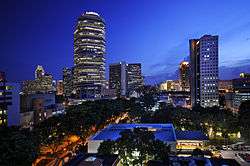Beach Road, Singapore
Beach Road is a road located within the planning areas of Kallang, Rochor and the Downtown Core in Singapore.
The road starts at its junction with Crawford Street in Kallang in the north, runs in a generally southerly direction, enters the Downtown Core at its junction with Ophir Road, and ends at its junction with Stamford Road and St. Andrew's Road to the south.
As its name implies, Beach Road used to run along Singapore's southern coast, before land reclamation took place in the Kallang Basin area.
Etymology and history

Beach Road is one of the early roads developed in Singapore and appears in George Drumgoole Coleman's 1836 Map of Singapore. The road was actually a coastal road fronting the sea coast in the early decades of the British colonial city – hence its name.
The Chinese used to call the road thih pa sat khau, meaning "the street to which the iron market opens or faces", a reference to Clyde Terrace Market, which was taken over and run as a public market by the Municipal Commissioners in 1910. Clyde Terrace Market, also known as Beach Road market, had its foundation stone laid on 29 March 1873, with Masonic honours. Costing $37,889, the building was completed in 1874. It was demolished in 1983 to make way for The Gateway twin office towers, designed by architect, I.M. Pei, which stand now on this site.
Beach Road was also known as sio poh kai ki in Hokkien, which means "small town seashore". Sio poh is "small town", referring to that part of Singapore to the north of the Stamford Canal Road, as opposed to tua poh or "big town", the Singapore River end of the town.
Beach Road was known as kadalkarai sadakku or "seaside road" in Tamil.
Up till the 1870s and 1880s, the sea came right up to Beach Road. At the time, large seaside villas stood here – just as Stamford Raffles had envisaged when he laid out his 1822 Town Plan. Raffles reserved Beach Road for the residences of the European merchants. By 1825, there were 20 such buildings. These luxurious homes earned the street its Chinese name ji chap keng or "Twenty House Street". In 1886, one of these 20 houses, owned by W.R. George, was bought over by the Sarkies brothers and later became the Raffles Hotel. By the 1880s, these houses were turned into hostels or eating places to cater to the increasing flow of travellers and Beach Road ceased to be a prestigious residential district.
Apart from houses, there were hotels, clubs and bars well. The Singapore Cricket Club had its roots here. The area was also the scene of frequent brawls, as in the days before Tanjong Pagar became the port area, European sailors on shore leave would make for Beach Road. Brawls and other unruly behaviour were the reason why Mrs Balestier, the first American consul's wife, presented the historic Revere Bell to Saint Andrew's Church in 1843. The bell was intended not only for church service but also to be struck in the afternoon to warn seamen to return to their ships before darkness fell.
A sandy beach once existed in front of Raffles Hotel on the Beach Road side, and may account for the few steps which today lead to the lobby, as apparently it was common for the water to come up and over Beach Road at high tide, before the land now in front of Beach Road was reclaimed.
The first land reclamation beyond the foreshore line of 1843 alongside Beach Road was to provide land to build the Alhambra and Marlborough Cinemas, a police station and the Singapore Volunteer Corps Headquarters and Drill Hall (later converted to the Singapore Infantry Regiment Headquarters). Further land reclamation began around the 1880s, gradually robbing Beach Road of its sea frontage. Over the years, Nicoll Highway and later Marina Square and Suntec City were built on reclaimed land, pushing Beach Road even further inland.
Landmarks

The prominent landmarks located along Beach Road include (from north to south):
- South Beach Residences, Mixed Development with Grade A offices, hotel and residential component
- DUO, a contemporary twin-tower integrated development comprising residences, offices, a 5-star hotel and retail gallery
- Golden Mile Complex and Golden Mile Tower
- Destination Singapore Beach Road
- Golden Mile Food Centre
- Masjid Hajjah Fatimah
- Saint John Headquarters
- The Concourse
- Parkroyal on Beach Road
- The Plaza
- The Gateway
- Shaw Tower
- Old Beach Road Police Station
- South Beach
- Raffles Hotel
- Civilian War Memorial and War Memorial Park
- Raffles City with Swissôtel The Stamford and Fairmont Singapore
Les Garçons Singapore
References
| Wikimedia Commons has media related to Beach Road, Singapore. |
- "Singapore Infopedia: Beach Road". National Library Board. Archived from the original on 12 June 2007. Retrieved 8 September 2006.
- Victor R Savage, Brenda S A Yeoh (2004), Toponymics – A Study of Singapore Street Names, Eastern University Press, ISBN 981-210-364-3
- National Heritage Board (2002), Singapore's 100 Historic Places, Archipelago Press, ISBN 981-4068-23-3